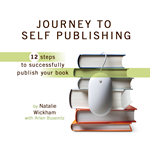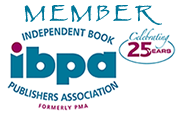Jun 28
I’ve been reading through The Prepublishing Handbook: What you should know before you publish your first book by Patricia J. Bell and found this sentiment both slightly humorous and quite relieving:
“You need to have a strong belief in yourself and your capabilities to do what has to be done. This need not be a major problem. If you were smart enough to write a good book, then you are smart enough to publish it. Remember, you can remedy ignorance through vigorous self-education.”
The more I dive into the world of self-publishing, the more I feel ready to drown in the sheer mass of information one must assimilate in order to proceed in an informed manner. I continue to feel increasingly ignorant! But Ms. Bell’s statement inspires me to engage in vigorous self-education. Perhaps eventually I’ll feel like I know something!
Jun 26
Check out this web page with easy-to-follow instructions for setting the distiller for embedding fonts in Adobe. Many printers that work with self-publishers require that you embed the fonts when you send them a pdf file, so I was really glad to find these instructions on how to do that.
Jun 25
By far, the website I visit the most every day is Dictionary.com. The link to it is positioned right in the center of my Bookmarks Toolbar so that I’m only a quick click away from looking up any word. Right under the box where you type in your desired word is a tab that will take you to Thesaurus.com. Numerous times when I’m writing I’ll need to look up the definition of a word to see if it has the nuance I intend. Or you know that feeling when the word is right at the tip of your brain, but you can’t formulate it? Often I can think of a similar word and I type it into the thesaurus to see if it will return the word I’m actually looking for.
Of course, these same strategies can be employed using the printed books sitting on the shelves above my desk, but having them just a click away sure does save a lot of time!
Jun 24
A couple of days ago I came across the Self Publishing website. The amount of information on the website is quite overwhelming! But you can order a free copy of their book, Publishing Basics – A Guide for the Small Press and Independent Self-Publisher that will help guide you through a lot of the resources available through their website. Just fill out the form to download the free e-book on this page. Then you will have the option to order a printed version of the book for free (+$1.99 shipping). I just finished the book today and not only is it chock-full of useful tips for self-publishers, it is also printed on various types of paper with examples of both offset and digital printing processes. This provides an excellent way to examine the difference between the papers and printing options available.
Publishing Basics is an excellent way to navigate through the terminology used in the publishing industry and sort through the conflicting information in the self-publishing industry. Here are a few of the helpful tips I gleaned:
1. Start your own publishing company and buy your own block of ISBN numbers. Do not buy a single ISBN number from another publishing house or author services company. If you do, they will own the ISBN and be listed as the book’s publisher.
2. Use MS Word for word processing, but not for book layout. If you aren’t inclined to purchase and learn to use a page layout software (Quark or PageMaker), it is well worth it to hire a professional to do the page layout design for you.
3. Print-On-Demand (POD) is a viable option for short-run jobs, but for a truly professional look, web offset printing is the way to go and can be used for print runs of 500 or more books.
Of course, much of the book is plugging the services offered by selfpublishing.com, but whether you use their services or not, it is an incredibly handy reference book (and well worth the $1.99 shipping charge)!
Jun 23
It’s amazing the things you come to find out about people when you tell them you are writing a book! At a wedding Saturday afternoon I enjoyed a conversation with a local artist. I found out that he has done book illustrations before and I eagerly jotted down his name and phone number to pass on to my friend who is writing a children’s book. Then, later that evening, at a cook-out at some friends’ house, I met someone else who does free-lance editing work. He was exciting about the possibility of helping me edit my book when I get to that point in the process. I know it will take a network of people to finish this project and it’s exciting to see the Lord bringing people across my path who are willing to be part of it!
Jun 23
After receiving a very friendly e-mail from a Jostens representative, I headed over to explore the website. They have a helpful list of 10 Commercial Book Printing Tips that will be handy to refer back to as I continue analyzing the various printing options available to self-publishers.
Jun 20
I was giving a workshop at our library this morning, so I took a few minutes after it was over to scour the shelves for books related to self-publishing. I by-passed some of the really old out-dated ones, but picked up a handful that I hope to skim through in the next several weeks. Here’s what I found:
Chicago Manual of Style – I’ve had a couple of questions recently about certain stylistic elements and thought this would be a handy reference. For example, I wasn’t sure whether to capitalize the word spring when referring to it as a season. Rule 8.94 in the 15th edition states, in part, “The four seasons are lowercased (except when used to denote and issue of a journal).” Question answered.
– I’ve had a couple of questions recently about certain stylistic elements and thought this would be a handy reference. For example, I wasn’t sure whether to capitalize the word spring when referring to it as a season. Rule 8.94 in the 15th edition states, in part, “The four seasons are lowercased (except when used to denote and issue of a journal).” Question answered.
The Prepublishing Handbook: What you should know before you publish your first book by Patricia J. Bell – Although the copyright date on this one is 1992, a seal on the cover identifies it as a recipient of the Benjamin Franklin Award from the Publishers Marketing Association. Not that I know what that means, but surely that makes it a book worth reading. Right? Plus, the Table of Contents looks very interesting and relevant.
– Although the copyright date on this one is 1992, a seal on the cover identifies it as a recipient of the Benjamin Franklin Award from the Publishers Marketing Association. Not that I know what that means, but surely that makes it a book worth reading. Right? Plus, the Table of Contents looks very interesting and relevant.
How to Publish and Promote Online by M.J. Rose and Angela Adair-Hoy – With a range of topics addressing both traditional print publishing and e-publishing, this book of 58 short chapters looks to be full of practical ideas and resources.
– With a range of topics addressing both traditional print publishing and e-publishing, this book of 58 short chapters looks to be full of practical ideas and resources.
How to Make Money Publishing from Home by Lisa Shaw – Covering the broad spectrum from books to newsletters to web sites to greeting cards and even software, this book seems to deal mostly with the business side of things. It looks like it covers a lot of the nitty-gritty details of the daily operations required of the self-publishing business.
– Covering the broad spectrum from books to newsletters to web sites to greeting cards and even software, this book seems to deal mostly with the business side of things. It looks like it covers a lot of the nitty-gritty details of the daily operations required of the self-publishing business.
Guerrilla Marketing for Writers: 100 Weapons for Selling Your Work by Jay Conrad Levinson, Rick Frishman & Michael Larsen – I’ve heard people in the business world rave about the Guerrilla Marketing books, so I was excited to see one specifically written for writers. Plus, I keep hearing that marketing is the key to a successful self-publishing venture. I hope to pick up lots of great ideas from this book!
– I’ve heard people in the business world rave about the Guerrilla Marketing books, so I was excited to see one specifically written for writers. Plus, I keep hearing that marketing is the key to a successful self-publishing venture. I hope to pick up lots of great ideas from this book!
I’ll be sure to report back with more thoughts as I read through each of these books in the coming weeks.
Jun 19
Here’s a handy glossary of terms to help the self-publisher navigate through the terminology of the publishing industry.
Jun 19
If you want to be inspired, take a tour of the Self-Publishing Hall of Fame where you can read the stories of hundreds of people who have written and successfully self-published their own books. I’ve only read through a few of them so far, but it definitely gave me an extra shot of confidence that in spite of the incredible amount of work involved, it is possible to be a successful self-publisher!
Jun 19
Here is a really helpful question and answer page that explains all the acronyms related to book publishing (like ISBN, LCCN, CIP, SAN, etc.), how to determine which ones you need, at what point in the process to purchase them and links to where to purchase them. I know I’ll be revisiting this page numerous times!







Recent Comments